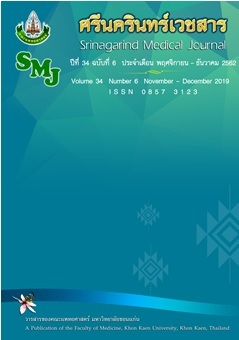Effects of the Eye-Hand Co-ordination Exercise with Modern Music on Fitness Balance based of Elderly People
Keywords:
Elderly, Eye-hand Co-ordination Exercise, Fitness Balance, ผู้สูงอายุ, การออกกำลังกายแบบประสานสัมพันธ์ (ตา-มือ), การทรงตัวAbstract
ผลการออกกำลังกายแบบประสานสัมพันธ์ (ตา-มือ) ประกอบเพลงสมัยนิยมต่อการทรงตัวของผู้สูงอายุ
อัตถสิทธิ์ ไชยณรงค์1* ,จุฬาภรณ์ โสตะ2
1 หลักสูตรวิทยาศาสตร์การออกกำลังกายและการกีฬา บัณฑิตวิทยาลัย มหาวิทยาลัยขอนแก่น
2 คณะสาธารณสุขศาสตร์ มหาวิทยาลัยขอนแก่น
หลักการและวัตถุประสงค์:ผู้สูงอายุเป็นวัยที่มีการเสื่อมถอยของสมรรถภาพทางกลไกของร่างกาย โดยเฉพาะด้านการทรงตัว ซึ่งเป็นปัจจัยเสี่ยงอย่างหนึ่งของการหกล้มในผู้สูงอายุ การออกกำลังกาย จะมีส่วนช่วยป้องกันการหกล้มได้ โดยจะต้องออกกำลังกายอย่างต่อเนื่อง มีระยะเวลาในการออกกำลังกายเหมาะสม ผู้วิจัยได้สร้างโปรแกรมการออกกำลังกาย ที่ปลอดภัย ทำได้ทุกพื้นที่ ประหยัดและมีความสนุกสนานเพลิดเพลิน วัตถุประสงค์เพื่อเปรียบเทียบความสามารถในการทรงตัวของผู้สูงอายุระหว่างกลุ่มทดลองและกลุ่มควบคุม
วิธีการศึกษา: เป็นการศึกษากึ่งทดลองทำการศึกษาในกลุ่มผู้สูงอายุสุขภาพดี อายุ 60-69 ปี จำนวน 60 ราย แบ่งเป็นกลุ่มทดลอง 30 ราย และกลุ่มควบคุม 30 ราย กลุ่มทดลองได้รับการฝึกโปรแกรมการออกกำลังกายแบบประสานสัมพันธ์ (ตา-มือ) ประกอบเพลงสมัยนิยมระยะ 12 สัปดาห์ กลุ่มควบคุมให้ใช้ชีวิตตามปกติ ทั้งสองกลุ่มมีการทดสอบความสามารถการทรงตัวลุกเดิน 8 ฟุต (8-Foot Up-and-Go Test)โดยทดสอบ ก่อนการฝึก หลังการฝึก 6 สัปดาห์ และหลังการฝึก 12 สัปดาห์ ใช้สถิติ Two-way Repeated Measures ANOVA
ผลการศึกษา: พบว่าความสามารถการทรงตัวลุกเดิน 8 ฟุต กลุ่มทดลองและกลุ่มควบคุมมีคะแนนเฉลี่ยแตกต่างกันอย่างมีนัยสำคัญทางสถิติ (F = 13.95, p < 0.05) มีคะแนนเฉลี่ยทั้งก่อนการฝึก หลังการฝึก 6 สัปดาห์ และ 12 สัปดาห์ แตกต่างกันอย่างมีนัยสำคัญทางสถิติที่ระดับ 0.05 (F = 33.95, p < 0.05) โดยกลุ่มทดลองมีพัฒนาการด้านการทรงตัวดีกว่ากลุ่มควบคุมตัวแปรเรื่องเวลาและตัวแปรเรื่องกลุ่มมีปฏิสัมพันธ์กันอย่างมีนัยสำคัญทางสถิติ (F = 19.18, p < 0.05)
สรุป: การฝึกโดยใช้โปรแกรมการออกกำลังกายแบบประสานสัมพันธ์ (ตา-มือ) ประกอบเพลงสมัยนิยมระยะ 12 สัปดาห์ สามารถเพิ่มความสามารถในการทรงตัวแบบมีการเคลื่อนไหวและอยู่กับที่ได้เป็นอย่างดี
Background and Objective: The elderly people has a deterioration of physical performance of the body, especially the balance which is one of the risk factors for falls in the elderly. The exercise will be one of the factors that could help protect falls, so the elderly must do exercise continuously and in an appropriate length of time. The researcher has created a safe exercise program that can be performed in every area, saving and having fun. Therefore, the purpose of this study was to compare balance ability of the elderly between the experimental and the control group.
Method: This study was the quasi-experimental design, and the 60 healthy elderly, whose ages are between 60-69 years old, were divided into the experimental and control groups by 30 elderly in each group. The experimental group received the training of the eye-hand coordination exercise with modern music for 12 weeks while the control group live normally. Both groups had balance tests including 8-Foot Up-and-Go Test. The elderly were tested before training, after 6-week training and after 12-week training. The two-way repeated measures ANOVA was used to analyze the data.
Results: It was found that the balance ability resulted from the 8-Foot Up-and-Go Test between the experimental and the control groups had the average scores at the significant different (F = 13.95, p < 0.05). Moreover, the average scores of before training, after 6-week training and 12-week training were significantly different at the level of 0.05 (F = 33.95, p <0.05), so it can be mentioned that the experimental group had better balance development than the control group. The variables of times and groups were statistical significance correlated (F = 19.18, p <0.05).
Conclusion: The training of the eye-hand coordination exercise with modern music for 12 weeks can increase the balance of movable and immovable abilities properly.
References
กรมกิจการผู้สูงอายุสถิติ. จำนวนผู้สูงอายุแยกตามจังหวัด และ อายุ ปี 2561 [เข้าถึงเมื่อ 18 มกราคม2562]; เข้าถึงได้จาก: URL: http://www.dop.go.th/th/know/1/159.
รายงานการสำรวจประชากรสูงอายุในประเทศไทย พ.ศ. 2557. สำนักงานสถิติจังหวัดขอนแก่น[เข้าถึงเมื่อ18 มกราคม 2562]; เข้าถึงได้จาก: URL:http://service.nso.go.th/nso/nsopublish/themes/files/elderly work Full Report57-1.pdf
สมลักษณ์ เพียรมานะกิจ,พัชรินทร์ พุทธรักษา,สุพิน สาริกา, วิไล คุปต์นิรัติศัยกุล. ความสามารถในการทรงตัวของผู้สูงอายุในชุมชนอำเภออัมพวา. วารสารกายภาพบำบัด 2560; 39: 52-62.
ดาราวรรณ รองเมือง. อุบัติการณ์ของการหกล้มและปัจจัยที่มีความสัมพันธ์กับการหกล้มในผู้สูงอายุที่อาศัยในชุมชน จังหวัดสุราษฎร์ธานี. วารสารวิทยาลัยพยาบาลพระปกเกล้า จันทบุรี 2559; 27: 123-38.
ญาดานุช บุญญรัตน์, กิตตินนท์ จรูญศรีสวสัดิ.การเปรียบเทียบผลระหว่างโปรแกรมการออกกำลังกายแบบพิลาทิสและการออกกำลังกายแบบฝึกการทรงตัวที่เกี่ยวข้องกับความมั่นใจในการทรงตัวของผู้สูงอายุในชุมชน. ศรีนครินทร์เวชสาร 2559; 31: 384-91.
ศิริมา เขมะเพชร. การออกกำลังกายเพื่อสุขภาพในผู้สูงอายุ. วารสารพยาบาลตำรวจ 2559; 8: 201-11.
Taylor-Piliae RE, Newell KA, Cherin R, Lee MJ, King AC, Haskell WL. Effects of Tai Chi and Western Exercise on Physical and Cognitive Functioning in Healthy Community-Dwelling Older Adults. J Aging Phys Act 2010; 18: 261–79.
Garber CE, Blissmer B, Deschenes MR, Franklin BA, Lamonte MJ, Lee IM, et al. Quantity and Quality of Exercise for Developing and Maintaining Cardiorespiratory, Musculoskeletal, and Neuromotor Fitness in Apparently Healthy Adults: Guidance for Prescribing Exercise. Med Sci Sports Exerc 2011; 43: 1334-59.
รัญชนา หน่อคำ, ศิริรัตน์ ปานอุทัย, ทศพล คำผลศิริ. ผลของการออกกำลังกายแบบก้าวตามตารางต่อการทรงตัวในผู้สูงอายุ. พยาบาลสาร 2559; 43: 58-68.
Lord S, Castell S. Effect of exercise on balance, strength and reaction time in older people. Aust J Physiother 1994; 40: 83-8.
เอกรัตน์ อ่อนน้อม, นฤพนธ์ วงศ์จตุรภัทร. ผลของดนตรีคัดสรรที่มีต่อความสามารถในการออกกำลังกาย. วารสารวิทยาศาสตร์และเทคโนโลยีการกีฬา 2557; 14: 151-61.
English T, Mavros Y, Jay O. Listening to motivational music mitigates heat-related reductions in exercise performance. Physiol Behav 2019; 208: 112567.


